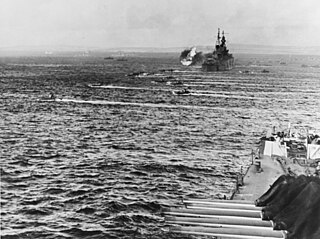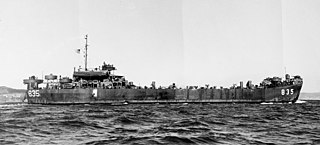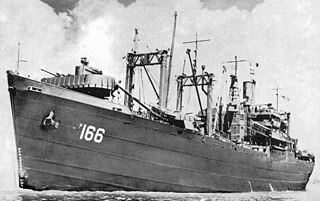Two ships of the United States Navy have been named USS Saipan, after the Battle of Saipan, one of the Northern Mariana Islands that was a scene of heavy fighting in World War II.

The Battle of Saipan was a battle of the Pacific campaign of World War II, fought on the island of Saipan in the Mariana Islands from 15 June to 9 July 1944 as part of Operation Forager. It has been referred to as the "Pacific D-Day" with the invasion fleet departing Pearl Harbor on 5 June 1944, the day before Operation Overlord in Europe was launched, and launching nine days after. The U.S. 2nd Marine Division, 4th Marine Division, and the Army's 27th Infantry Division, commanded by Lieutenant General Holland Smith, defeated the 43rd Infantry Division of the Imperial Japanese Army, commanded by Lieutenant General Yoshitsugu Saito. The loss of Saipan, with the deaths of at least 29,000 troops and heavy civilian casualties, precipitated the resignation of Prime Minister of Japan Hideki Tōjō and left the Japanese archipelago within the range of United States Army Air Forces B-29 bombers.
USS ''LST-84'' was one of the hundreds of Tank landing ships built during World War II to support amphibious military operations. Her role was to carry significant quantities of vehicles, cargo, and troops directly onto an unimproved shore. The ship was sponsored by Mrs. W. Raymond Brendel. The ship was constructed inland at Jeffersonville, Indiana, by the Jeffersonville Boat & Machine Co. as coastal ship yards were used to build larger naval vessels. The ship traversed the Ohio and Mississippi River to reach open water.
The second USS Whippet (IX-129), an Armadillo-class tanker designated an unclassified miscellaneous vessel, was the second ship of the United States Navy to be named for the whippet. Her keel was laid down on 31 October 1943 at New Orleans, Louisiana, by the Delta Shipbuilding Company under a Maritime Commission contract. She was launched on 15 December 1943 sponsored by Mrs. Will Camp Sealy, delivered to the Navy on 13 January 1944, and commissioned on 14 January 1944 with Lieutenant Commander R. Parmenter in command.

USS Ulysses (ARB-9) was planned as a United States Navy LST-542-class tank landing ship, but was redesignated as one of twelve Aristaeus-class battle damage repair ships built for the United States Navy during World War II. Named for Ulysses, she was the second US Naval vessel to bear the name.
USS Heed (AM-100) was an Auk-class minesweeper built for the United States Navy during World War II. She earned five battle stars for her World War II service. She was recommissioned during the Korean War. She was placed in reserve in 1954 and remained there until struck from the Naval Vessel Register in 1967.

USS LST-853 was an LST-542-class tank landing ship in the United States Navy during World War II. Later in her U.S. Navy career she was renamed Kane County (LST-853)—after counties in Illinois and Utah—but never saw active service under that name.
USS LST-900 was an LST-542-class tank landing ship in the United States Navy during World War II. Late in her career, she was renamed Linn County (LST-900)—after counties in Iowa, Kansas, Missouri, and Oregon—but saw no active service under that name.

USS Sederstrom (DE-31) was a Evarts-class destroyer escort of the United States Navy during World War II. She was promptly sent to the Pacific Ocean to escort convoys and to protect other ships from Japanese planes and submarines. Her assignments took her from one battle area to another, but she was fortunate in remaining almost unscathed by the end of the war. For her efforts in battle areas, she was awarded five battle stars by war's end.

USS Cabana (DE-260) was an Evarts-class destroyer escort constructed for the United States Navy during World War II. The namesake of this ship, Napoleon Joseph Cabana, was born in Fairhaven, Massachusetts on 26 March 1911, Cabana enlisted in the Navy on 17 March 1930 and was appointed machinist on 2 February 1941. As assistant safety engineer of the Cavite Navy Yard, Philippines, he was killed in action during Japanese attacks on that base on 12 December 1941.

USS LST-119 was a LST-1-class tank landing ship built for the U.S. Navy during World War II. She was designed to carry troops and military equipment to the shores of the battle front and quickly deliver her cargo. She served in the Pacific Ocean and post-war returned home proudly with two battle stars to her credit.

USS LST-835 was an LST-542-class tank landing ship built for the United States Navy during World War II. Late in her career, she was renamed Hillsdale County (LST-835) — after Hillsdale County, Michigan, the only U.S. Naval vessel to bear the name — but saw no active service under that name.
USS Lyon County (LST-904) was an LST-542-class tank landing ship built for the United States Navy during World War II. Named after counties in Iowa, Kansas, Kentucky, Minnesota, and Nevada, she was the only U.S. Naval vessel to bear the name.
USS Papaya (AN-49/YN-68) was anAilanthus-class net laying ship which served with the U.S. Navy in the South Pacific Ocean theatre of operations during World War II. Her career was without major incident, and she returned home after the war bearing two battle stars to her credit.

USS Plumas County (LST-1083) was an LST-542-class tank landing ship in the United States Navy. Unlike many of her class, which received only numbers and were disposed of after World War II, she survived long enough to be named. On 1 July 1955, all LSTs still in commission were named for US counties or parishes; LST-1083 was given the name Plumas County, after Plumas County, California.

USS Livingston (AP-163/AK-222) was a Crater-class cargo ship built for the US Navy during World War II. She was responsible for delivering troops, goods and equipment to locations in the Asiatic-Pacific Theater.

USS Lakewood Victory (AK-236) was a Boulder Victory-class cargo ship acquired by the U.S. Navy during World War II. She served in the Pacific Ocean theatre of operations through the end of the war, earning two battle stars, and then returned to the United States for disposal.

The third USS Comet (AP-166) was a United States Navy La Salle-class transport in commission from 1944 to 1946. She saw service in the Pacific Theater of Operations during the latter stages of World War II and the immediate postwar period.
USS LST-34 was a United States Navy LST-1-class tank landing ship used exclusively in the Asiatic-Pacific Theater during World War II. Like many of her class, she was not named and is properly referred to by her hull designation.

Naval Base Saipan or Naval Advance Base Saipan or Naval Air Base Saipan was a United States Navy Naval base built during World War II to support Pacific Ocean theater of war and the many warships and troops fighting the war. The base was on the island of Saipan in the Northern Mariana Islands. The base was part of the Pacific island hopping campaign. The base construction started after the Battle of Saipan ended on July, 9 1944. US Naval Advance Base Saipan was constructed by the Seabees Naval Mobile Construction Battalions. The base was under the Commander Naval Forces Marianas. Saipan is 12 miles (19 km) long and 5 miles (8.0 km) wide. About 70% of the island was sugarcane cultivation at the start of the base construction. At the start of the Battle of Saipan, the island's population had about 30,000 Japanese troops and about 20,000 Japanese civilians. The city of Garapan was the administrative center for the Saipan governmental district.











